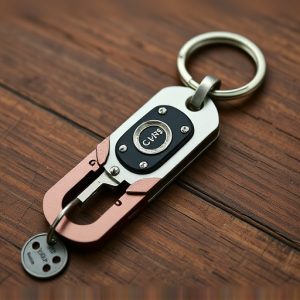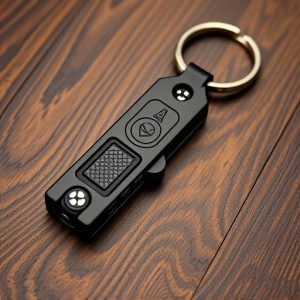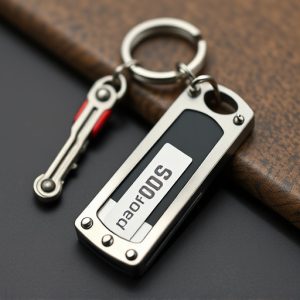Personal Alarm Keychains: Legal Carry & Decibel Power in States
Protective keyring devices, known as Personal Alarm Keychains, with loud decibels (105-120) have gai…….
Protective keyring devices, known as Personal Alarm Keychains, with loud decibels (105-120) have gained popularity for self-defense. Legalities vary by state, with some permitting their use without restrictions while others require permits or specific conditions. These keychains serve as powerful deterrents, featuring high-quality consistent sound to startle assailants and alert authorities. With compact designs attaching easily to keys, they offer peace of mind in various situations. Key features to consider include water resistance, ease of activation, and added tools for enhanced functionality during emergencies.
“Uncover the power of personal protection with protective keyring devices, especially in states where legal carry is permitted. This comprehensive guide explores the world of ‘loud’ keychains and their potential as self-defense tools. We delve into the legal aspects, understanding that decibel levels play a crucial role. From bustling cities to remote areas, certain states embrace the concept of legal carry for personal alarm keychains. Discover the benefits, use cases, and essential features to ensure you choose the right device for your peace of mind.”
- Understanding Protective Keyring Devices: A Legal Perspective
- Decibels and Personal Alarms: What You Need to Know
- States Embracing Legal Carry of Loud Keychains
- Benefits and Use Cases for Personal Alarm Keychains
- Choosing the Right Device: Features and Considerations
Understanding Protective Keyring Devices: A Legal Perspective
Protective keyring devices, often equipped with personal alarms and designed to emit loud decibels, have gained prominence as a legal means of self-defense. These compact tools are easily portable, allowing individuals to carry them on their keys for quick access in case of emergencies. From a legal perspective, the use and carriage of such devices vary across states, with some embracing them as a viable option for personal safety while others may have restrictions or require permits.
Understanding the legal framework surrounding protective keyring devices is crucial for users to ensure they remain within the boundaries of the law. In many states, these devices are classified as personal alarms or self-defense tools, subject to specific regulations regarding volume levels and circumstances of use. With the rising popularity of such devices, it’s essential for individuals to stay informed about their rights and responsibilities to make informed decisions regarding personal safety measures.
Decibels and Personal Alarms: What You Need to Know
Personal alarms designed for keychains often tout their decibel levels as a key feature, but what does this mean? In simple terms, decibels measure sound intensity. A higher decibel level means a louder sound. Typically, personal alarms aimed at self-defense or emergency situations range from 105 to 120 decibels, which is significantly louder than everyday household sounds. This high volume can serve as a powerful deterrent and draw attention in an emergency, helping to ensure your safety.
When choosing a Personal Alarm Keychain, consider the loud decibels not just for the shock factor but also for its practical application. The noise should be enough to startle an assailant and alert nearby individuals or authorities. Remember, the goal is to create a chaotic situation that disorients potential threats, so a device with consistent, high-quality sound is essential.
States Embracing Legal Carry of Loud Keychains
In recent years, several states have recognized the value and importance of allowing individuals to carry personal alarm keychains for self-defense purposes. These states have enacted laws permitting loud decibel keychains, empowering citizens to protect themselves in various situations. The concept behind this legal carry is to provide an accessible and readily available means of deterring potential threats, especially in urban areas known for their hustle and bustle.
States embracing legal carry of loud keychains understand the significance of personal safety. By allowing such devices, they enable folks to take a proactive approach to security, ensuring peace of mind while navigating through bustling metropolitan landscapes. This shift reflects a modern approach to self-defense, where innovative tools like personal alarm keychains play a pivotal role in enhancing individual safety without compromising comfort or mobility.
Benefits and Use Cases for Personal Alarm Keychains
Personal Alarm Keychains offer a convenient and portable solution for personal safety, especially in situations where one might feel vulnerable or isolated. These compact devices are designed to emit a powerful sound, typically reaching loud decibels, that can startle potential assailants and draw attention, allowing users to escape quickly. The benefits extend beyond their auditory capabilities; they serve as a psychological deterrent, giving individuals a sense of security and control over their safety.
Use cases range from everyday carry for increased personal security to specific scenarios like hiking, camping, or even attending late-night events. Their compact size makes them easily attachable to keys, ensuring easy accessibility. In an emergency, a simple press of a button triggers the alarm, providing immediate assistance and potentially deterring dangerous situations.
Choosing the Right Device: Features and Considerations
When selecting a protective keyring device, it’s crucial to consider several features that ensure your safety. Look for devices with a powerful Personal Alarm Keychain that can emit loud decibels—typically 120dB or higher—to deter potential attackers and draw attention. The device should be compact and lightweight, fitting comfortably on your keyring without adding significant bulk. Water resistance is another valuable feature, especially if you frequently encounter wet environments.
Consider the ease of activation as well; some devices offer simple one-touch triggers while others have more complex mechanisms. Evaluate whether you prefer a button or a twist-to-activate design based on your personal preference and comfort level. Additionally, check for additional tools like a bottle opener, window breaker, or LED light that can enhance its functionality during emergencies.
Protective keyring devices, particularly those emitting loud decibels as personal alarms, have gained legal recognition in several states. These compact yet powerful tools offer enhanced safety and security for individuals across diverse situations. By embracing the legal carry of loud keychains, states are empowering citizens to take control of their personal safety. With various benefits and use cases ranging from self-defense to emergency notifications, the personal alarm keychain has proven to be a valuable asset in today’s world. When choosing a device, consider features like decibel level, ease of use, and durable design to ensure the right protection for you.


